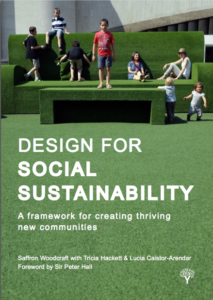Mind the crap: Socially successful but not socially just?
 Oh dear. How many times have we been here before, and how many times must we go here again? Design for Social Sustainability: A framework for creating thriving communities (April 2012) is a report from the The Young Foundation, a non-profit, non-governmental think tank based in London that specializes in insights, innovation and entrepreneurship to meet social needs. The report was commissioned jointly by the U.K. government’s Homes and Communities Agency as part of its Future Communities programme (a partnership between government and the Young Foundation).
Oh dear. How many times have we been here before, and how many times must we go here again? Design for Social Sustainability: A framework for creating thriving communities (April 2012) is a report from the The Young Foundation, a non-profit, non-governmental think tank based in London that specializes in insights, innovation and entrepreneurship to meet social needs. The report was commissioned jointly by the U.K. government’s Homes and Communities Agency as part of its Future Communities programme (a partnership between government and the Young Foundation).
The authors of the report however appear to have missed what a lot of us have been writing, researching and teaching about for decades and have themselves just discovered the ‘social’ side of sustainability. They are of course eager to tell us all about their great idea, so let’s take a look at it. Aside from the spectacularly un-diverse imagery in the report, problematic terms like ‘social success‘ and ‘social design’ litter the pages with no explanation as to what they mean nor how they should be achieved:
“We need a better understanding of how to create socially successful communities and how to use planning, development and stewardship functions to achieve this goal.”
And:
“Social sustainability is an issue of public value as well as the wellbeing, quality of life and satisfaction of future residents. It demands a new approach to planning, design and development that we call social design, which needs to be integrated into policy and professional practice across all the disciplines involved in the creation of new communities – much like the way standards of environmental sustainability have become widely adopted in recent years.”
However, if these banal and ill defined terms weren’t enough, the most egregious omission is of any consideration of social justice. The term simply does not appear. Neither does equality. The term equity appears twice, once in terms of negative equity, and once in an Oxford Institute for Sustainable Development definition of social sustainability. How on earth, or perhaps on the moon, does the Young Foundation think that communities can ever be remotely socially successful without a fundamental and intentional commitment to social justice? Have the authors not read and digested the implications of Wilkinson and Pickett’s book The spirit level: Why equality is better for everyone? I’m not going to waste my time giving chapter and verse on this. Read their book. Read my books. Read my blog.
And you know the biggest irony in all this? The Future Communities Programme, of which this Design for Social Sustainability report is the latest offering, was launched in June 2010 with the publication of the unfortunately and presciently named report Never again: Avoiding the mistakes of the past.
Never again? Avoiding mistakes? Past, present, future? I’m not so sure anymore…
Thank you for this Julian
I am doing my PhD at the University of Salford UK SOBE. I am a chartered building surveyor with an interest in what I term socially just accessible sustainability. I have found when researching or even on interviewing built environment professionals that they define sustainability almost totally as a ‘green’ issue. A chap called Kevin Murphey @The social Pillar, the missing Pillar’ has contributed a substantial Ph.D. thesis.
My focus is on suggesting the development of a new core module to be undertaken by all built environment professionals. “Socially just, sustainable accessible design” Or something along the same. I am new at this Ph.D. business and would value any comments. I have just watched your You Tube video from the 2010 AASHE conference and found it very insightful and presented in a none rocket science accessible fashion.
Terry Duerden MRICS